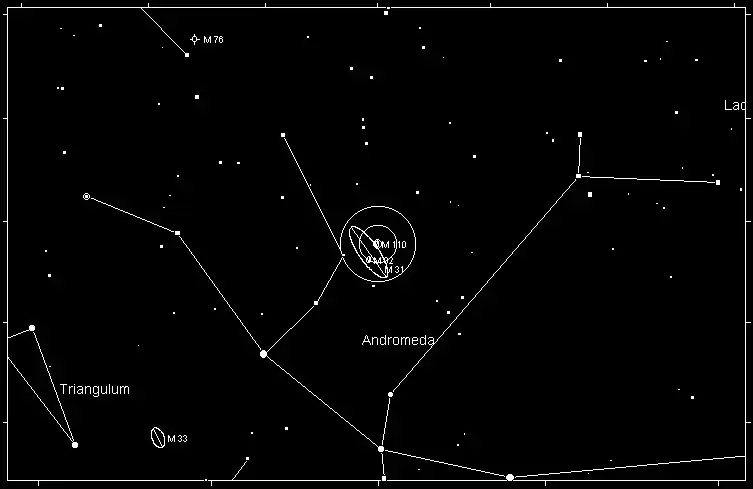Messier 110 (M110), also known as NGC 205, is a dwarf elliptical galaxy that orbits the Andromeda Galaxy (M31). Located about 2.69 million light-years from Earth, it is the second-brightest satellite galaxy of Andromeda and is classified as a dwarf elliptical type (dE6p). Despite its small size, M110 contains several interesting features, including dust clouds, something unusual for galaxies of its type. The galaxy has an apparent size of 21.9 x 10.9 arcminutes, making it a notable object for amateur astronomers, especially when observing its parent galaxy.
Magnitude
M110 has an apparent magnitude of +8.1, which makes it one of the fainter objects in the Messier catalog. While it is not visible to the naked eye, it can be seen with small telescopes under dark skies, particularly when observed as part of the larger Andromeda Galaxy system.
Prominent Season
M110 is best observed during the autumn and early winter months in the Northern Hemisphere. The constellation Andromeda, where it resides, is most prominent from September to January. The best time to observe M110 is during late October when Andromeda is high in the sky during the evening hours.
Constellation
M110 is located in the constellation Andromeda, near its more famous companion, the Andromeda Galaxy (M31). Andromeda is one of the larger constellations in the northern sky and is home to several notable deep-sky objects, including Messier 31, Messier 32, and Messier 110. It is part of the Andromeda family of constellations, which includes Cassiopeia, Perseus, and Pegasus.
How to Find M110
Finding M110 requires locating its much brighter neighbor, the Andromeda Galaxy (M31). To locate M31 and M110, start by finding the constellation Andromeda. The easiest way to do this is by locating the Great Square of Pegasus. From the top left star of the square (Alpheratz), move towards the next two stars in Andromeda (Mirach and Almach). M31 can be found between Mirach and Almach, extending northwest. Once you've located the Andromeda Galaxy, M110 will appear as a faint, elongated object just northwest of the galaxy’s core. In small telescopes, M110 may appear as a fuzzy patch, while larger telescopes can resolve more of its elliptical shape.

History
Messier 110 has an interesting observational history. It was discovered by Charles Messier on August 10, 1773, but was not included in his original Messier catalog. The omission of M110 from Messier's catalog is curious, given that he recorded it in his notes when observing M31. It wasn't until 1966 that Kenneth Glyn Jones added M110 to the Messier catalog based on Messier's original observations.
Prior to Messier's observation, the galaxy was possibly noted by other astronomers. Caroline Herschel, the sister of William Herschel, observed the object in 1783, and William Herschel later cataloged it as H V.18 in 1784.
M110's classification as a dwarf elliptical galaxy makes it an object of interest in the study of galaxy formation and evolution, particularly regarding how smaller galaxies interact with and are affected by their larger counterparts like Andromeda. The presence of dust clouds in M110 also suggests that it has undergone recent star formation, which is uncommon for galaxies of its type.
Conclusion
Messier 110 is a fascinating satellite galaxy of Andromeda and a rewarding target for amateur astronomers. Though faint, its proximity to the Andromeda Galaxy makes it an achievable observation for small telescopes. Observing M110 offers a glimpse into the complex interactions between galaxies and the evolution of dwarf elliptical galaxies in the Local Group. The best time to view M110 is during the fall and winter months, when Andromeda is most prominent in the night
